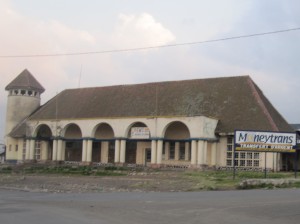Goma, Nord-Kivu February 4th
 Goma’s central post office is a colonial era building built in a faux Norman modernist style from the 1930s with a steep pitched terra cotta tile roof, a large round turret anchoring one side and an entrance way with wide arches. At one point it was a busy place—the centre of the communication technology of the time. That was a long time ago. It is a museum now, almost. There are wooden post boxes, not used in years, worn desks and ancient weigh scales and a wall of shelves full of dusty old letters. At the entrance a few older men with type writers sit at tables, next to a shabby photocopy machine and a small generator. Their customers are, presumably, illiterate people who come and dictate letters.
Goma’s central post office is a colonial era building built in a faux Norman modernist style from the 1930s with a steep pitched terra cotta tile roof, a large round turret anchoring one side and an entrance way with wide arches. At one point it was a busy place—the centre of the communication technology of the time. That was a long time ago. It is a museum now, almost. There are wooden post boxes, not used in years, worn desks and ancient weigh scales and a wall of shelves full of dusty old letters. At the entrance a few older men with type writers sit at tables, next to a shabby photocopy machine and a small generator. Their customers are, presumably, illiterate people who come and dictate letters.
I have some post cards to mail home: one a picture of Barack Obama—who is still a hero in Africa—and the other of gorillas in the nearby Virunga National Park, being sent to my six year old niece and to whom I explain, to the extent the space allows, that they are the animals closest to people and that if you are nice to them in the wild they will let you get near.
I paid $2 each, and saw 400 Congolese Francs—50¢—worth of stamps, licked and affixed to them. After, the women in charge took the post cards, opened a wooden cupboard, and placed them inside.
I found out later there’s been no postal service here in years.
All those dusty old letters in the Goma post office, lying around in cubby holes and inside drawers, would tell a tale. They would be time capsule vignettes, snap shots of lives, the times as they were, love letters where the moment has long past; fevered, lengthy accounts from young aid workers trying to explain to the folks back home the tragedies and suffering witnessed in some other chapter of Congo’s string of tragedies. There would be letters from people in small villages writing to distant relatives, in the capital, or maybe Europe, asking for help, sharing news. And there would also be letters asking why there has been no reply to all the messages sent.
